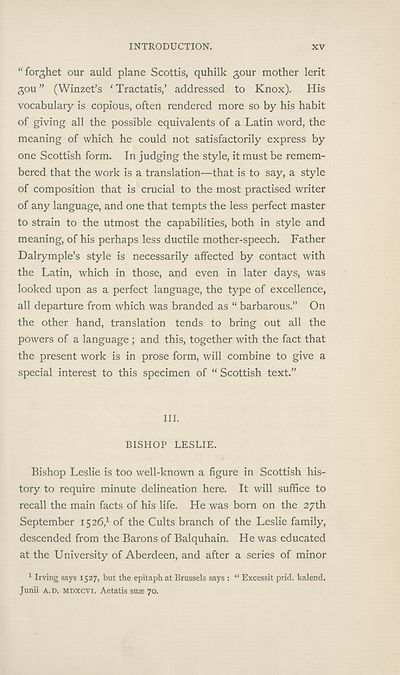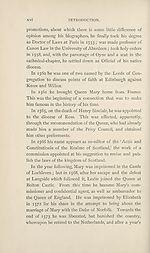Scottish Text Society publications > Old series > Historie of Scotland > Volume 1, 1888
(19) Page xv
Download files
Complete book:
Individual page:
Thumbnail gallery: Grid view | List view

INTRODUCTION.
xv
“forghet our auld plane Scottis, quhilk gour mother lerit
gou ” (Winzet’s ‘Tractatis,’ addressed to Knox). His
vocabulary is copious, often rendered more so by his habit
of giving all the possible equivalents of a Latin word, the
meaning of which he could not satisfactorily express by
one Scottish form. In judging the style, it must be remem¬
bered that the work is a translation—that is to say, a style
of composition that is crucial to the most practised writer
of any language, and one that tempts the less perfect master
to strain to the utmost the capabilities, both in style and
meaning, of his perhaps less ductile mother-speech. Father
Dalrymple’s style is necessarily affected by contact with
the Latin, which in those, and even in later days, was
looked upon as a perfect language, the type of excellence,
all departure from which was branded as “ barbarous.” On
the other hand, translation tends to bring out all the
powers of a language ; and this, together with the fact that
the present work is in prose form, will combine to give a
special interest to this specimen of “ Scottish text.”
III.
BISHOP LESLIE.
Bishop Leslie is too well-known a figure in Scottish his¬
tory to require minute delineation here. It will suffice to
recall the main facts of his life. He was born on the 27th
September 1526,1 of the Cults branch of the Leslie family,
descended from the Barons of Balquhain. He was educated
at the University of Aberdeen, and after a series of minor
1 Irving says 1527, but the epitaph at Brussels says : “ Excessit prid. kalend.
Junii a. D. mdxcvi. Aetatis suse 70.
xv
“forghet our auld plane Scottis, quhilk gour mother lerit
gou ” (Winzet’s ‘Tractatis,’ addressed to Knox). His
vocabulary is copious, often rendered more so by his habit
of giving all the possible equivalents of a Latin word, the
meaning of which he could not satisfactorily express by
one Scottish form. In judging the style, it must be remem¬
bered that the work is a translation—that is to say, a style
of composition that is crucial to the most practised writer
of any language, and one that tempts the less perfect master
to strain to the utmost the capabilities, both in style and
meaning, of his perhaps less ductile mother-speech. Father
Dalrymple’s style is necessarily affected by contact with
the Latin, which in those, and even in later days, was
looked upon as a perfect language, the type of excellence,
all departure from which was branded as “ barbarous.” On
the other hand, translation tends to bring out all the
powers of a language ; and this, together with the fact that
the present work is in prose form, will combine to give a
special interest to this specimen of “ Scottish text.”
III.
BISHOP LESLIE.
Bishop Leslie is too well-known a figure in Scottish his¬
tory to require minute delineation here. It will suffice to
recall the main facts of his life. He was born on the 27th
September 1526,1 of the Cults branch of the Leslie family,
descended from the Barons of Balquhain. He was educated
at the University of Aberdeen, and after a series of minor
1 Irving says 1527, but the epitaph at Brussels says : “ Excessit prid. kalend.
Junii a. D. mdxcvi. Aetatis suse 70.
Set display mode to: Large image | Zoom image | Transcription
Images and transcriptions on this page, including medium image downloads, may be used under the Creative Commons Attribution 4.0 International Licence unless otherwise stated. ![]()
| Publications by Scottish clubs > Scottish Text Society publications > Old series > Historie of Scotland > Volume 1, 1888 > (19) Page xv |
|---|
| Permanent URL | https://digital.nls.uk/107369060 |
|---|
| Attribution and copyright: |
|
|---|
| Description | A collection of over 100 Scottish texts dating from around 1400 to 1700. Most titles are in Scots, and include editions of poetry, drama, and prose by major Scottish writers such as John Barbour, William Dunbar, Gavin Douglas, and George Buchanan. Edited by a key scholarly publisher of Scotland's literary history, and published from the late 19th century onwards by the Scottish Text Society. Available here are STS series 1-3. |
|---|

